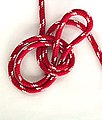Bowline on a bight
| Bowline on a Bight | |
|---|---|
 | |
| Category | Loop |
| Related | Double bowline |
| Releasing | Non-jamming |
| Typical use | Forming a loop in the middle of a length of rope. |
| ABoK | #1080 |
The bowline on a bight is a knot which makes a pair of fixed-size loops in the middle of a rope. Its advantage is that it is reasonably easy to untie after being exposed to load. It is one of the two tie-in knots that are being taught by the German Alpine Club (DAV), generally being considered secure.[1][2][3]
Dangers
2011 testing shows that the knot might slip when only one loop is loaded. Cavers and canyoneers ought to fasten their cow-tail carabiner through both loops.[4] European cavers widely advocate the use of a figure eight twisted version of the bowline on a bight.
Applications
This knot can be used to provide a toe hold in the middle of a rope; to make an emergency bosun's chair;[5][6] and to create an upper rope "block" to make a crude purchase by threading the rope round an anchor point and then back up through the loop. It is sometimes used in sport climbing to tie into two anchor bolts independently. This knot is convenient when a dependable loop is required but neither end of the line is available. It's also commonly used as a seat while being hoisted as there are two secure loops as opposed to the traditional one loop bowline. In theory, this knot would make hoisting many people with one line possible. This knot is very popular in caving as it allows the load to be spread between two anchor points, reducing the stress placed on them and providing a backup should one fail. Commonly known as the Y-hang it allows for a free-hang descent and can be easily adjusted to avoid waterfalls or rub points.
As mentioned earlier, this knot can replace the figure-eight knot when tying into a climbing harness by tying a regular bowline knot and then re-threading it, such as is done with a figure eight knot. However, it is critical to use a strong backup knot with plenty of tail beyond the knot, as the knot may untie during long climbs. The advantage of using this knot instead of the figure eight knot is that it can be easily untied after a severe fall.
Technique
The bight of rope is initially used to make a bowline in the usual way (picture on right). However, the bowline is not completed by going on round the standing end(s) and tucking the bight back down beside itself. Instead, the bight is opened up to allow the whole knot to pass through it (see picture on right). When tightened, the bight now embraces the pair of standing ends (see top picture)
- 1
- 2
- 3
- 4
- 1
- 2
- 3
Notes and references
- ^ "Duell der Knoten: Achter versus Bulin (Duel of the knots: Figure-eight vs. Bowline)". Klettern.de. 28 April 2011. Archived from the original on Jun 22, 2019.
Der gesteckte Achterknoten und der doppelte Bulin erfüllen diese Anforderungen. Es sind deshalb auch die beiden Einbindeknoten, die der Deutsche Alpenverein bei seinen Kursen lehrt, wobei der Achterknoten bei Einsteigern den Vorzug erhält, weil er sich leichter kontrollieren lässt.
- ^ "Know-How Am Berg – Wesentliches zu Ausrüstung, Planung und Seiltechnik (engl: Know-how on the mountain – Essentials of equipment, planning and rope handling" (PDF). DAV. Archived (PDF) from the original on June 24, 2019. Retrieved July 4, 2019.
Der Achterknoten, in diesem Fall als „gesteckter Achter" oder als „doppelter Bulin" ausgeführt, dient als Anseilknoten.
- ^ "So binden Sie sich richtig ein und so bitte nicht! (This is how you tie yourself in properly and this is how you don't do it!)". Alpin. Archived from the original on Oct 13, 2018.
- ^ "Noeuds". Archived from the original on 2012-05-21. Retrieved 2012-06-03. Video with genuine et voilà! ending (in French)
- ^ Ashley, Clifford W. (1944). The Ashley Book of Knots (PDF). Doubleday. p. 195. Archived from the original (PDF) on 2018-12-19.
- ^ {{ }}
See also
External links
- Grog. "Bowline on a bight using rope". Animated Knots.







